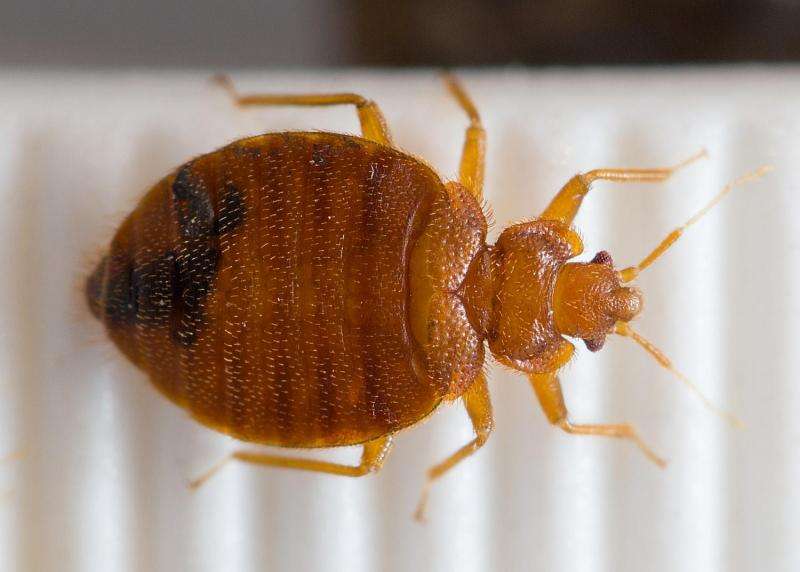Researchers sequence bedbug genome, find unique features

Purdue University researchers participated in a multi-institute project that sequenced the genome of the common bedbug, a blood-sucking insect that has reemerged globally as a hardy pest capable of withstanding most major classes of insecticides.The genome of Cimex lectularius uncovers the genetic underpinning of bedbugs' unique biology and offers new targets for controlling them. Purdue entomologists Ameya Gondhalekar and Michael Scharf contributed to the international effort by annotating the bugs' antioxidant genes, which detoxify the blood they ingest and likely play a role in disarming certain types of insecticides.
"Bedbugs were the ignored pests for many decades, but their sudden prevalence has sparked interest in developing better bedbug control measures and knowing more about their biology," said Gondhalekar, assistant professor of entomology. "The genome provides a much-needed platform for answering these questions at a deeper level."
Bedbugs have plagued humans for at least three thousand years, emerging at night to feed on blood, their sole source of nutrition and water. Widespread use of insecticides in homes after World War II curtailed their numbers dramatically, but over the past two decades, the bedbug has rebounded from near eradication in many regions to extraordinary levels of infestation on every continent except Antarctica. Infestations in Australia alone have risen 4,500 percent.
The bug's unexpected comeback is likely due to a surge in international travel, the exchange of secondhand goods and the pest's evolution of resistance to many conventional insecticides, said Scharf, the O. Wayne Rollins/Orkin Chair in Molecular Physiology and Entomology.

"Nobody was ready for this," he said. "It's reached almost a crisis condition. All big cities in the U.S. are experiencing problems. Our culture had forgotten about bedbugs, and two generations of entomologists haven't had to deal with them."
The genome shows that bedbugs have developed multiple ways of resisting insecticides. Their armor-like outer cuticle sports barriers and detoxification genes that help prevent insecticides from penetrating. Many bedbugs have also evolved new forms of sodium channels, gates in the nervous system that insecticides such as pyrethroids are designed to target and disrupt. The bugs might also detoxify ingested pesticides using the same robust antioxidant enzyme system they use to detoxify blood, the researchers said.
The genome indicated substantial inbreeding among bedbugs, suggesting that genetic resistance to pesticides can spread across populations.
Many of the bedbug genes associated with pesticide resistance have similar forms in other insects such as mosquitoes and fruit flies, but Scharf and Gondhalekar pinpointed antioxidant genes that appear to be unique to bedbugs, offering possible targets for genetic control measures.
Other factors that make bedbugs tough to control are their abilities to survive for months without a bloodmeal, easily hitchhike on clothes and luggage, feed stealthily and stow away in furniture and mattresses. Many insecticides can only be applied to cracks, crevices and baseboards, allowing the bugs to hide during spraying and emerge unscathed later.
"It only takes one pregnant bedbug to jumpstart an infestation of a whole building," Scharf said.
Adult bedbugs can grow up to a quarter inch long and are flat, reddish-brown insects that resemble oversized versions of their sister species, the pea aphid. They use piercing-sucking mouthparts to penetrate human skin and slurp up a blood meal, typically leaving behind an itchy, red welt.
Severity of reactions to bedbug bites can vary widely, and the genome provides researchers with molecular resources to investigate whether proteins produced by bedbugs can cause allergies.
Though the bugs do not transmit disease, scratching bedbug bites can result in secondary infections, and infestations can exert a psychological toll, the researchers said.
People in infested homes can suffer from stress, paranoia, poor quality of sleep, insomnia and depression.
"Once you have bedbugs, everything changes," Gondhalekar said. "You devote all your attention to getting rid of them."
Previous research by Purdue entomologist Timothy Gibb showed that even people who mistakenly thought their homes were infested showed an increase in depression and distanced themselves from others.
"People feel vulnerable," Scharf said. "You're being fed upon by something that drinks your blood while you're sleeping."
The genome also revealed that bedbugs have a significantly lower number of chemosensory genes compared with many other insects, possibly due to the bedbugs' host specificity. They have inherited genes from symbiotic bacteria that provide essential nutrients lacking in blood. Bedbugs also have a large number of genes that code for resilin, which gives their cuticle elasticity. This adaptation likely helps female bedbugs recover after traumatic insemination, a mating process in which the male stabs the female's abdomen with dagger-like genitalia.
The researchers said that pesticide companies could leverage these genomic resources to screen the effectiveness of available chemicals, lowering the cost of getting new insecticides to market.
"Fortunately, we've now got the genome early in the game," Scharf said. "Having this knowledge now might enable us to prevent bedbugs from becoming pests at the level of German cockroaches or disease-transmitting mosquitoes."
More information: Joshua Benoit, University of Cincinnati; Coby Schal, North Carolina State University; Stephen Richards, Baylor College of Medicine; et al. Online Feb. 2, 2016, in Nature Communications DOI: 10.1038/ncomms10165 , dx.doi.org/10.1038/ncomms10165
Journal information: Nature Communications
Provided by Purdue University


















